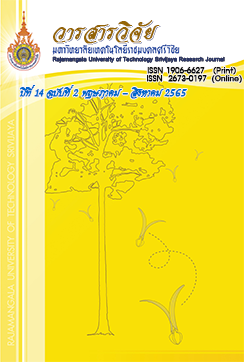Energy Conservation of Traditional Sugar Factory: A Case Study of Rerm-Udom Sugar Factory
Keywords:
sugar factory, steam boiler, energy conservationAbstract
The energy efficiency of traditional sugar factories is relatively low. This research aims to explore, measure, and analyze the causes of energy loss in the factory to propose energy conservation measures for Rerm Udom Sugar Factory, Udon Thani Province. The result shows that the most significant loss can be categorized into four sections. Therefore, four energy conservation measures are proposed. (1) The economizer for increasing boiler efficiency was installed due to heat loss through exhaust gas. This can increase boiler efficiency by 3.8% - equivalent to electricity produced of 292,716 kWh/year and corresponding to 1,229,409 Baht per year. The payback period is 5.86 years; (2) The blowdown controller was installed because of heat loss from blowdown. This helps to increase boiler efficiency by 0.3% which equates to the electricity produced of 85,738 kWh/year and corresponding to 360,098 Baht per year. The payback period is 3.05 years; (3) The installation of 2 inches thick insulation around the condensate tank was done due to radiation heat loss from the condensate tank. This helps to increase power generation by 79,454 kWh/year, corresponding to 333,708 Baht/year, and the payback period is 1.28 years; and (4) Heat loss was due to improper steam management in the factory. The measure was to preliminarily use produced steam from the boiler for power generation. After that, the lower temperature steam from the steam turbine was supplied to the production processes. This helps to increase the electricity generation by approximately 820,829 kWh/year, corresponding to 3,447,481 Baht per year.
References
Ahmed, M. and Babiker, M. 2017. Effect of Boiler Feed Water Quality in Textile and Other Industries. Gezira Journal of Engineering & Applied Science 12(1): 16-30.
Arjharn, W. 2010. Research Report on Study of a biomass feedstock production plant for rural. Suranaree University of Technology. (in Thai)
Association, J.S. 1993. Land boilers-Heat balancing. JIS B8222:1993, Tokyo, Japan.
Chooprasert, P. and Limpiteeprakarn, T. 2011. Potential Assessment for Bagasse Drying using Heat Recovery in Sugar Factory, pp. 508-514. In Proceedings of the 7th Conference On Energy Network of Thailand (E-NETT); 2011. Phuket. (in Thai)
Chooprasert, P. Suluksna, K. and Tummu, P. 2020. Improvement of boiler efficiency for Rerm-
Udom sugar factory. pp. 1-8. In Proceeding of the 13th International Conferences Thai Society of Agricultural Engineering (TSAE2020). Nakhon Ratchasima, Thailand.
Department of Industrial Works. 2018. Guide to improving the efficiency of very small biomass power plants. The Energy Policy and Planning Office (EPPO), Bangkok. (in Thai)
Department of Renewable Energy Development and Energy Efficiency. 2015. Alternative Energy Development Plan: AEDP2015. The Energy Policy and Planning Office (EPPO), Bangkok. (in Thai)
Eiamworawutthikul, C. 2018. Energy Saving Estimation Template (EnSET). Available Source: https://WWW.sites.google.com/spu.ac.th/enset/home, November 17, 2018. (in Thai)
Ekburanawat, J. and Thongsongyod, C. 2013. Mixed straw biomass electrical power generation system by using gasification technology. Available Source: https://WWW.repository.rmutr.ac.th/bitstream/handle/123456789/503/Fulltext.pdf?sequence=1&isAllowed=y, August 23, 2013. (in Thai)
Gul, S. and Harasek, M. 2012. Energy saving in sugar manufacturing through the integration of environmental friendly new membrane processes for thin juice pre-concentration. Applied Thermal Engineering 43: 128-133.
Khoodaruth, A. 2014. Optimisation of a Cogenerated Energy Systems, The Cane Biomass Flexi-factory Case Study. Energy Procedia 62: 656-665.
Rahman, M.M. and Paatero, J.V. 2012. A methodological approach for assessing potential of sustainable agricultural residues for electricity generation, South Asian perspective. Biomass and Bioenergy 47: 153-163.
Sathitbun-anan, S., Fungtammasan, B., Barz, M., Sajjakulnukit, B. and Pathumsawad, S. 2014. Energy efficiency and greenhouse gas emission reduction potentials in sugar production processes in Thailand. Energy for Sustainable Development 23: 266-274.
Sergeevich, K.L., Valerevna, K.O. and Dmitrievna, T.A. 2018. A Method for Steam Boilers Load Optimization. IFAC-PapersOnLine 51(32): 765-769.
Sungkaew, W. 2015. Potential of Oil Palm Biomass Residues for Electricity Generation in Southern Thailand. Master of Engineering (Mechanical Engineering), Prince of Songkla University. (in Thai)
The Department of Alternative Energy Development and Efficiency (DEDE). 2009. Biomass Database Potential in Thailand. Available Source: http://WWW.dede.go.th, October 15, 2009. (in Thai)
The Energy Policy and Planning Office (EPPO). 2018. Thailand Power Development Plan 2018. Available Source: http://WWW.eppo.go.th, March 30, 2018. (in Thai)
The Energy Policy and Planning Office (EPPO). 2020. Renewable Energy Power Plant Information. Available Source: https://www.dede.go.th, August 1, 2020. (in Thai)
Wongrat, W. and Sookkumnerd, C. 2015. A Model of System Improvement for Electricity Cogeneration Sugar Factories. Farm Engineering and Automation Technology Journal 1(1): 33-41. (in Thai)
Downloads
Published
How to Cite
Issue
Section
License
Copyright (c) 2022 Rajamangala University of Technology Srivijaya Research Journal

This work is licensed under a Creative Commons Attribution-NonCommercial-NoDerivatives 4.0 International License.
The content and information in the article published in Journal of Rajamangala University of Technology Srivijaya It is the opinion and responsibility of the author of the article. The editorial journals do not need to agree. Or share any responsibility.







